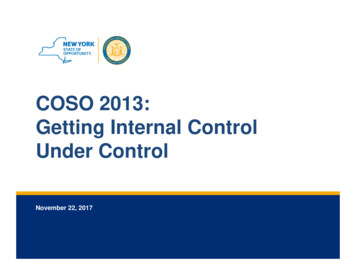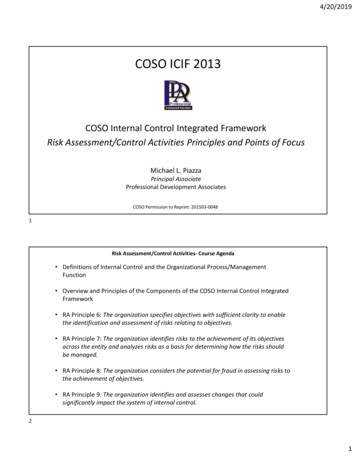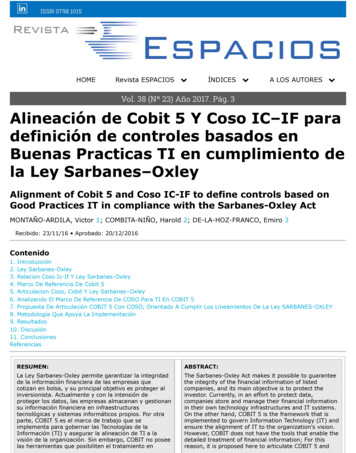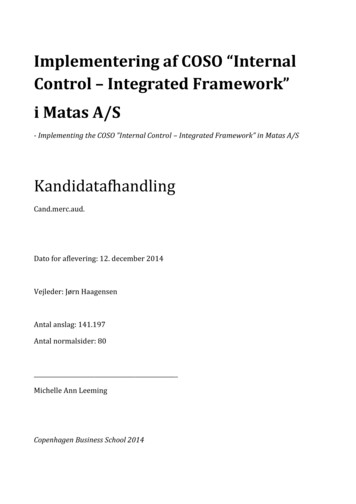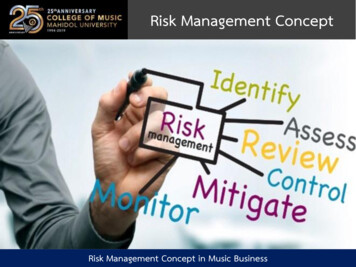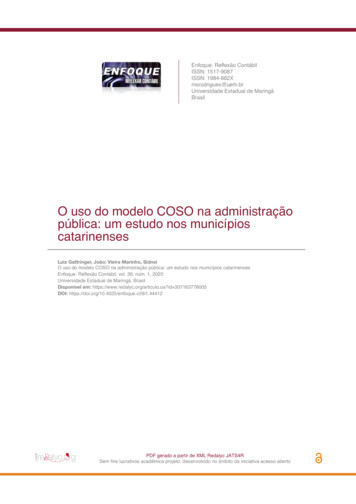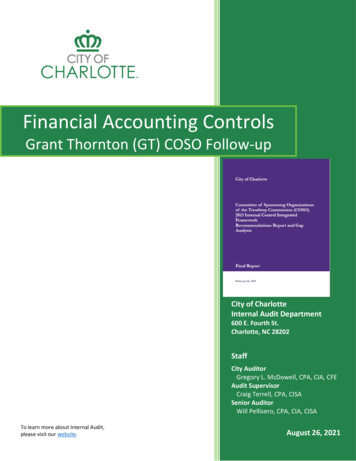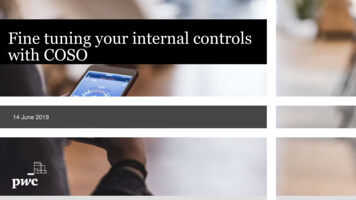
Transcription
Journal of Business Cases and ApplicationsVolume 28Using COSO online resources: the internal control – integratedframework (2013) and compendium bundleSusan L. SwangerWestern Carolina UniversityN. Leroy KauffmanWestern Carolina UniversityABSTRACTIn May 2013, the Committee of Sponsoring Organizations (COSO) released its newInternal Control - Integrated Framework, replacing the framework that had been in place since1992. Access to the COSO resources have been made available to schools through the AmericanAccounting Association (AAA). Those resources include the Internal Control - IntegratedFramework (2013), tools for assessing the effectiveness of internal controls, and a compendiumof approaches and examples related to the internal controls of external financial reporting. Tointroduce students to the framework and the vast resources provided on the COSO website, aseries of short classroom assignments were developed requiring students to: review the fundamental concepts of the framework itself (the five components andseventeen principles); explore the tools and compendium to search for specific examples to meet the needs of ahypothetical company; report findings in a concise written form; and, demonstrate to the audience of fellow classmates the use of the COSO resources,including their research protocol.This paper presents the assignment, teaching notes including a grading rubric, and studentfeedback on the assignment.Keywords: COSO, internal controls, auditingCopyright statement: Authors retain the copyright to the manuscripts published in AABRIjournals. Please see the AABRI Copyright Policy at http://www.aabri.com/copyright.htmlUsing COSO online resources, Page 1
Journal of Business Cases and ApplicationsVolume 28INTRODUCTIONA shared goal of accounting programs is that students are prepared to enter the workforcewith usable tools and skillsets. This goal is shared by both graduate and undergraduateprograms, although the skillsets for graduate programs may be a bit more focused on skillsrequired by the public accounting profession.There are several challenges encountered along the way to accomplishing this goal. Formany accounting programs, most courses are focused on quantitative aspects ofaccounting. Debits, credits, Balance Sheets, Income Statements, and Statements of Cash Flowsdominate the instructional space. Most courses are focused primarily on having the rightnumbers and being able to determine definitive answers. Auditing courses are typically near theend of their program. Students enter this class with similar expectations on what they willencounter, namely, more procedures and computations to derive definitive answers. They comeinto the auditing course with a history of several courses of financial accounting, managerialaccounting, cost accounting, tax accounting and a cadre of analytical tools to analyze and presentdata. They are often somewhat surprised by the lack of journal entries and computations tosupport definitive answers.These challenges have been the focus of several previous studies. Boyle and Lloyd(2013) noted that auditing focuses on qualitative aspects which often do not have specificdefinitive answers in quantitative terms. Boyle and Lloyd (2013) point out that auditing is more astudy of “accountANTS rather than accountING.” This shifting focus can present challenges tostudents who are very accustomed to making computations and seeking specific answers.Auditing students must adopt a different thought process when learning the subject material.(Driskill and Pittman, 2018). Knechel (2000) agrees that accounting educators must createlearning environments that provide students with hands-on experiences to enhance their masteryof auditing topics. It was confirmed, as well, by Davidson (2017) and Healy and McCutcheon(2008) that active learning contributes to the learning process in audit education.The Accounting Education Change Commission (1990) encouraged active learningenvironments for students to experience more real-world like situations. Driskill and Pittman(2018) posit that a hands-on experience with an audit problem will significantly increase thestudent’s knowledge and transfer of theoretical methods and models within the profession andbetter prepare students for their entry into the profession.Bonner (1999) shows that understanding and gaining expertise in a complicated subject,such as auditing, is enhanced with active learning instructional methods. Grabinger and Dunlap(1995) presented a REAL (Rich Environments for Active Learning) definition which includedfive steps: (i) student responsibility and initiative, (ii) generative learning activities, (iii)authentic learning contexts, (iv) authentic assessment strategies, and (v) co-operative support.They posit that REALs provide learning activities that engage students in a continuouscollaborative process of building and reshaping understanding as a natural consequence of theirexperiences and interactions within learning environments that authentically reflect the worldaround them. They conclude that each REAL attribute builds upon and uses the others. None ofthe attributes are mutually exclusive, and no one attribute is more important than another. Youcannot implement one feature without incorporating the others to some degree. This case studyincorporates all the aspects of an active learning, or REAL, activity.The new CPA licensure model keeps audit as one of the three core skill areas. In the 2019Trends in the Supply of Accounting Graduates and Demand for Public Accounting Recruits, itUsing COSO online resources, Page 2
Journal of Business Cases and ApplicationsVolume 28was noted that practitioners were increasingly advising schools that accounting curricula need tohelp students gain a better understanding of technology and its application within the profession.To wit, the following case study incorporates many of these previous ideas. Students arepresented with a very real situation where they use technology resources to explore and find ananswer to a posed question, working cooperatively with their peers. Students have responsibilityto find the answer, they must take initiative to search for the answer, the question is authentic,authentic assessment strategies are used to evaluate their work, and there is co-operative supportas they develop an acceptable solution to present to their peers.PURPOSE OF ASSIGNMENT AND LEARNING GOALSThe National Commission on Fraudulent Financial Reporting, first chaired by James C.Treadway in 1985 and oft referred to as the “Treadway Commission,” was sponsored by fiveindependent organizations, collectively known as the Committee of Sponsoring Organizations(COSO). The five organizations are the American Accounting Association (AAA), theAmerican Institute of Certified Public Accountants (AICPA), the Financial Executives Institute(FEI), the Institute of Internal Auditors (IIA) and the Institute of Management Accountants(IMA). The work of COSO has focused on providing resources and guidance related to internalcontrols, enterprise risk management (ERM), and fraud deterrence. It’s first major projectresulted in the 1992 publication “Internal Control - Integrated Framework,” which served as thebackbone of controls over financial reporting for both public and private entities until 2013 whenthe framework was updated and revised. COSO also unveiled a related compendium ofapproaches and examples. Both the Framework and the Compendium were rolled out in anonline format available to the public by subscription through the AICPA. Access for educationalinstitutions is available through the AAA.To introduce students to the framework and the vast resources provided on the COSOwebsite, a case study assignment was developed requiring students to: review the fundamental concepts of the framework itself (the five components andseventeen principles); explore the tools and compendium to search for specific examples to meet the needs of ahypothetical company; report findings in a concise written form; and, demonstrate to the audience of fellow classmates the use of the COSO resources,including their research protocol.The motivation for designing the current assignment was the age-old challenge ofincluding necessary technical content into a specific course when the sheer volume of thatcontent continues to grow dramatically. Specifically, the technical content and skill developmentin the traditional Auditing classroom has blossomed over the past 20 years, due in large part tothe creation of the Public Company Accounting Oversight Board in 2002 as an additionalregulator and standard-setter. To help auditing instructors make efficient use of classroom time,it is beneficial to minimize the time and resources spent revisiting content that had beenpresented to students in a previous course. Thus, this “bridge” type of assignment wasdeveloped to review the fundamentals of the COSO Integrated Framework (learned in a priorsemester in the Accounting Information Systems class) so that current Auditing class time couldbe devoted to the auditor's consideration of internal control in planning and performing afinancial statement audit. An additional motivation was to provide a vehicle that allows theUsing COSO online resources, Page 3
Journal of Business Cases and ApplicationsVolume 28students to familiarize themselves with the resources provided on the COSO website. Theassignment was developed for and used in a graduate-level Auditing course but would also beappropriate to use at the undergraduate level.The assignment was designed to achieve two major objectives:Objective 1: To serve as a review of the COSO Integrated Framework (2013), knowledge that ispart of the technical content of the Accounting Information Systems course students took duringthe prior semester;Objective 2: To serve as an introduction to the online resources available on the COSO website,including the 2013 Framework and Compendium of approaches and examples.Specific learning goals associated with the above objectives are that students will:1. Improve understanding of the elements of COSO’s framework2. Gain confidence in working with/doing research on COSO’s website3. Gain an awareness of the content of the COSO website4. Demonstrate research skills5. Write effectively6. Demonstrate ability to present information orally7. Work effectively in teams.ASSIGNMENT DESCRIPTIONFines Creek Company is a privately-owned company located in North Carolina,specializing in feed for domestic animals and pets. Annual sales revenues are 7 million, andtotal assets are 15 million. The company plans to have a private equity placement of 10million in approximately 1 year, so that the processing plant can be upgraded and expanded tomeet anticipated increases in demand of their high-quality pet food for dogs and cats.The current CEO, John Daniels, has sent you, the CFO, the following email: “I was at aconference last week and met a guy from Minnesota who was lamenting how his auditors andaudit committee had been critical of the company’s internal controls. His company was planningto have a public offering in a few years, but now have put those plans on hold until they clean uptheir act. I was shocked! I know just enough about internal controls to be dangerous I needyour help!”“Because we plan to have our first audit next year, I think this is something we need to befocusing on. For the next management team meeting, I would like for you to do a little researchand put together a handout for everyone – basically, an Internal Control Primer. What areinternal controls? What are the components of the internal controls and the related principles?This should be something that the managers can understand not too technical.”From that point, each of the emails differs slightly, as set forth in Table 1 (Appendix),each asking the recipient to use the COSO resources and report back to the CEO. The first fiveof the variations asked that the individual to research how the company might easily implementsome of the COSO guidance relating to each of the five components: Control Environment, RiskAssessment, Control Activities, Information & Communication, and Monitoring. Other tasksincluded defining what “effective” actually means and what constitutes a “deficiency,”summarizing guidance for smaller entities, locating templates that can be used, and makingcomparisons to the Enterprise Risk Management (ERM) Framework.Using COSO online resources, Page 4
Journal of Business Cases and ApplicationsVolume 28TEACHING NOTESDuring the second week of class, students were randomly assigned to three-person teams.The instructor led a short introductory session to explain how to access the COSO resources viathe university’s learning management system. Access to the COSO resources is passwordprotected and is available for purchase at a discount for educational institutions through theAmerican Accounting Association. Each team then selected a number from a bowl, whichcorresponded to one of the nine case scenarios. The instructor then emailed the appropriate casescenario email messages from “John Daniels” to each student group. Students were givenapproximately three weeks to work together outside of class time to complete the assignment.Deliverables from the student groups were:1. An internal control Primer handout, intended to be used in a business meeting of nonaccountants;2. A handout related to the assigned research question, again with an intended audience ofnon-accountants; and,3. An in-class demonstration of the group’s research protocol using the COSO website,limited to 10 minutes.Groups submitted their handouts via the Learning Management System two days prior tothe presentation date, so that the instructor could check the accuracy of the information prior topresentation to the class.A grading rubric was used, as presented in Figure 1 (Appendix). Students had prioraccess to the rubric when the assignment was introduced, so they were aware of how they wouldbe assessed. The design of the rubric allows considerable leeway for instructors to providespecific feedback on the three components of the assignment: the internal control primerhandout, the handout addressing the research question, and the presentation. Students werereminded during class meetings to make sure their submissions addressed the intended audience.Overall, group grades ranged from 83.25% to 100%. The 20-point assignment representedapproximately 5% of the overall course grade.The assignment was used for four separate semester-long graduate auditing classes. Overthe four semesters, 80 students completed the assignment, with 56 students (70%) completing asurvey that provided feedback, summarized in Tables 2 and 3 (Appendix).The students expressed overwhelmingly positive responses to questions relating to howthe assignment served as a good review of COSO components (94%), enhanced theirunderstanding of the elements of the framework (98%), improved their ability to find COSOrelated materials (100%), and made them feel more confident in their ability to research COSOrelated questions (98%). Further, the students acknowledged that accountants and auditors mightfind the information on the COSO website useful in the “real world” (93%). Despite the volumeof information contained on the COSO website, students were able to find what they werelooking for (96%) and did not encounter information overload (55%). It was encouraging that63% of the students disagreed or strongly disagreed with the statement that they have no interestin learning anything else about this material.Regarding responses about the project itself, students reported that they had sufficienttime to complete the project (98%) and acknowledge the value of hands-on simulation as a wayto learn about something (98%). Responses about like/dislike of team projects were evenly split(48% and 50%), although a majority of students indicated that they preferred the assignmentUsing COSO online resources, Page 5
Journal of Business Cases and ApplicationsVolume 28over straight lecture about the materials (66% and 62%). Generally, they seemed to enjoy theproject (59%) and recommend that it be continued in future auditing classes (82%).The last question in the survey was an open-ended question, asking participants toprovide other comments and suggestions about the assignment. Selected representativecomments are included in Table 4 (Appendix). Suggestions from students that were laterincorporated into the project were to post the handouts on the learning management system sothey could be shared among class members, and giving students the option to work individuallyrather than in teams.Using COSO online resources, Page 6
Journal of Business Cases and ApplicationsVolume 28REFERENCESAccounting Education Change Commission (AECC). (1990). Objectives of education foraccountants: Position statement number one. Issues in Accounting Education, 5(2), 307–312.American Institute of Certified Accountants (AICPA). (2019). 2019 Trends in the Supply ofAccounting Graduates and the Demand for Public Accounting Recruits. New York:American Institute of Certified Public Accountants.Bonner, S. E. (1999). Choosing teaching methods based on learning objectives: An integrativeframework. Issues in Accounting Education, 14(1), 11-39.Boyle, E.J. & Lloyd, S.J. (2013). Writing audit programs for tests of controls: a practice basedpedagogical methodology. The Accounting Educators’ Journal, 23, 93-111.Davidson, S. M. (2017). Instructional case for auditing students: understanding internal controlsand assessing control risk. Journal of Business Cases and Applications, 17. Retrievedfrom ill, T. & Pittman, K. (2018). Inventory observation: Applied case study for audit students.Journal of Business Cases and Applications, 20. Retrieved rabinger, R. S. & Dunlap, J. C. (1995). Rich environments for active learning: adefinition, ALT-J, 3:2, 5-34, DOI: 10.1080/0968776950030202.Healy, M. & McCutcheon, M. (2008). Engagement with active-learning: reflections on theexperiences of Irish accounting students. Irish Accounting Review, 15 (1), 31-49.Knechel, W. R. (2000). Behavioral research in auditing and its impact on audit education. Issuesin Accounting Education, 15(4), 695-712.Using COSO online resources, Page 7
Journal of Business Cases and ApplicationsVolume 28APPENDIXVersion1Table 1Text of John Daniels’ Email (Differences Underlined)Then, I think we should start getting our own house in order for InternalControls over Financial Reporting. I think we should start with theControl Environment. Take a look at the COSO Compendium resourcesand find a few approaches and strategies that we should be able to quicklyimplement so we can get started on this. Include those in yourhandout/presentation, also. We’ll deal with the other components later.Be prepared to go over your handout with the group andexplain/demonstrate where you got your information at our next meetingon February 8th.2Then, I think we should start getting our own house in order for InternalControls over Financial Reporting. I think we should start with RiskAssessment. Take a look at the COSO Compendium resources and find afew approaches and strategies that we should be able to quicklyimplement so we can get started on this. Include those in yourhandout/presentation, also. We’ll deal with the other components later.Be prepared to go over your handout with the group andexplain/demonstrate where you got your information at our next meetingon February 8th.3Then, I think we should start getting our own house in order for InternalControls over Financial Reporting. I think we should start with theControl Activities. Take a look at the COSO Compendium resources andfind a few approaches and strategies that we should be able to quicklyimplement so we can get started on this. Include those in yourhandout/presentation, also. We’ll deal with the other components later.Be prepared to go over your handout with the group andexplain/demonstrate where you got your information at our next meetingon February 8th.4Then, I think we should start getting our own house in order for InternalControls over Financial Reporting. I think we should start with theInformation & Communication. Take a look at the COSO Compendiumresources and find a few approaches and strategies that we should be ableto quickly implement so we can get started on this. Include those in yourhandout/presentation, also. We’ll deal with the other components later.Be prepared to go over your handout with the group andexplain/demonstrate where you got your information at our next meetingon February 8th.Using COSO online resources, Page 8
Journal of Business Cases and Applications5Volume 28Then, I think we should start getting our own house in order for InternalControls over Financial Reporting. I think we should start withMonitoring. Take a look at the COSO Compendium resources and find afew approaches and strategies that we should be able to quicklyimplement so we can get started on this. Include those in yourhandout/presentation, also. We’ll deal with the other components later.Be prepared to go over your handout with the group andexplain/demonstrate where you got your information at our next meetingon February 8th.6Then, I think we should start getting our own house in order for InternalControls. I think we should start with the basics. Take a look at theCOSO Framework resources and summarize for the group what“effective” actually means, and what constitutes a “deficiency.” Includethose in your handout/presentation, also. We’ll deal with the othercomponents later.Be prepared to go over your handout with the group andexplain/demonstrate where you got your information at our next meetingon February 8th.7Then, I think we should start getting our own house in order for InternalControls. I think we should start with the basics. Take a look at theCOSO Framework resources and summarize for the group the guidancethat is available for smaller entities, like us. Include those in yourhandout/presentation, also.Be prepared to go over your handout with the group andexplain/demonstrate where you got your information at our next meetingon February 8th.8Then, I think we should start getting our own house in order for InternalControls. I think we should start with the basics. Take a look at theCOSO Framework resources and try to find some templates that we canuse for overall and component assessment. Include those in yourhandout/presentation, also.Be prepared to go over your handout with the group andexplain/demonstrate where you got your information at our next meetingon February 8th.9I’d also like to see a summary of how this compares to the Enterprise RiskManagement Framework (ERM), because that is where we should beheaded in the future. Include that in your handout, too.Be prepared to go over your handout with the group andexplain/demonstrate where you got your information at our next meetingon February 8th.Using COSO online resources, Page 9
Journal of Business Cases and ApplicationsVolume 28Table 2Questions related to the value of the learning experience:(Learning Goals 1 through 4)This project enhanced my understanding of the elements ofthe COSO Framework.98% agreed orstrongly agreedI have a better understanding of how the COSO Frameworkmight be applied in a real-world situation.95% agreed orstrongly agreedThis assignment made me feel more confident in my abilityto research COSO-related questions that might arise.98% agreed orstrongly agreedI believe accountants and auditors might find the informationon the COSO website useful in the “real-world.”93% agreed orstrongly agreedIt was easy to find what I was looking for in the COSOwebsite.77% agreed orstrongly agreedThis assignment was a useful review of the COSOframework.94% agreed orstrongly agreedI have a better understanding of where to find COSOmaterial after completing this assignment.100% agreed orstrongly agreedI found what I was looking for in the COSO website.96% agreed orstrongly agreedThe COSO website felt like “information overload.”45% disagreed orstrongly disagreedThis assignment did not improve my understanding of whereto find COSO material.97% disagreed orstrongly disagreedI do not feel I understand the elements of the COSOframework any better after completing this assignment.89% disagreed orstrongly disagreedI do not believe my ability to research questions related toCOSO was improved by this assignment.81% disagreed orstrongly disagreedI have no interest in learning anything else about thismaterial.63% disagreed orstrongly disagreedResponsesUsing COSO online resources, Page 10
Journal of Business Cases and ApplicationsVolume 28Table 3Other questions on student attitudes toward the project:(Learning Goals 5 through 7)Simulation (hands-on with simulated problems) is a valuableway to learn about something.Responses98% agreed orstrongly agreedI recommend using this project in future auditing classes.82% agreed orstrongly agreedI was provided sufficient time to complete the project.98% agreed orstrongly agreedI preferred this assignment over straight lecture on thematerial.66% agreed orstrongly agreedI enjoyed working on this project.59% agreed orstrongly agreedI enjoy team-based projects.48% agreed orstrongly agreedThis project helped me learn to be a better writer of businessmaterial.57% neither agreenor disagreeI do not like to learn in an environment that requires workingwith a team of students.50% disagreed orstrongly disagreedI would have preferred straight lecture on the material overthis particular assignment.62% disagreed orstrongly disagreedUsing COSO online resources, Page 11
Journal of Business Cases and Applications Volume 28Table 4 – Open-ended ResponsesEnjoyed the project. Liked the group aspect of it, too.It was a very simple and straightforward assignment. It needs to be a little morechallenging. I do not know how though, but it was too easy. I do think studentsneed to look at this website because I would have never used it if we did not lookat it for this class. Moreover, I would not have had access.I thought this was a good assignment to get us familiar with the COSO website. Idid indeed find the website to [sic] a bit of information overload beforecompleting this assignment and after I felt much more comfortable with it. It wasalso good to work through this assignment with a team member.I liked the part about making it a handout, however, in the future, I think the classshould submit their handouts to a class-wide discussion board, so that everyonecan go back on their own time and review the information that other groupsfound.Maybe researching another topic within the group would be helpful. That wouldgive a bit more to present on.The COSO handout on internal controls that each group had to make was a goodway of summarizing the information collected. However, it might be morebeneficial if the group has to explain the information they found to the rest of theclass, to put the information in a powerpoint slideshow with screenshots of eachpage they used from the COSO website.I think it may have been helpful had we gone through the sections prior to theassignment so that we had a little better understanding of how to navigate the site.I believe this assignment could be assigned to only one person instead of a group.I enjoy team based projects, but not this one Perhaps the collaboration couldhappen during scheduled class sessions, instead of [sic] independantly.Using COSO online resources, Page 12
Journal of Business Cases and ApplicationsVolume 28Figure 1 – COSO Assignment Grading RubricUsing COSO online resources, Page 13
backbone of controls over financial reporting for both public and private entities until 2013 when the framework was updated and revised. COSO also unveiled a related compendium of approaches and examples. Both the Framework and the Compendium were rolled out in an online format available to the public by subscription through the AICPA.


